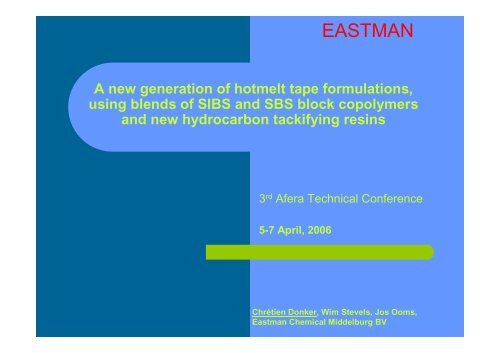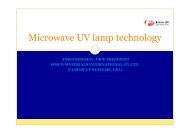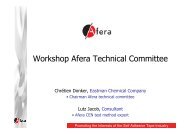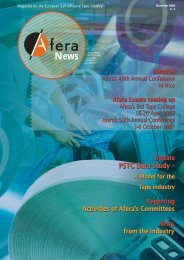EASTMAN - Afera
EASTMAN - Afera
EASTMAN - Afera
You also want an ePaper? Increase the reach of your titles
YUMPU automatically turns print PDFs into web optimized ePapers that Google loves.
<strong>EASTMAN</strong><br />
A new generation of hotmelt tape formulations,<br />
using blends of SIBS and SBS block copolymers<br />
and new hydrocarbon tackifying resins<br />
3 rd <strong>Afera</strong> Technical Conference<br />
5-7 April, 2006<br />
Chrétien Donker, Wim Stevels, Jos Ooms,<br />
Eastman Chemical Middelburg BV
Introduction<br />
<strong>EASTMAN</strong><br />
� World wide isoprene monomer shortage results<br />
in reduced availability of SIS block copolymers<br />
for hot melt PSA formulations<br />
� KRATON Polymers introduced SIBS as an<br />
alternative block copolymer with lower isoprene<br />
content to the HMPSA market<br />
� Specially designed aromatic modified C5 resins<br />
are necessary to tackify SIBS
<strong>EASTMAN</strong><br />
How to cope with SIS shortage?<br />
� Use SBS as block copolymer in the formulation, although<br />
processability and options for tackification limit the formulation<br />
window for HMPSA<br />
� Blends of SIS and SBS are used with variable results<br />
� With the new SIBS, more blends are now possible:<br />
- SIBS with SIS<br />
- SIBS and SBS<br />
� Using blends of SIBS and SBS would reduce dependency<br />
on isoprene monomers
<strong>EASTMAN</strong><br />
Block copolymer blends<br />
� SIS and SBS block copolymers are known<br />
to have limited compatibility<br />
� SIBS is compatible with both SIS and SBS<br />
� SIBS/SBS blends need specifically designed<br />
tackifying resins to give optimum HMPSA<br />
performance
<strong>EASTMAN</strong><br />
Block copolymer blends<br />
G " ( )<br />
[Pa]<br />
G ' ( )<br />
[Pa]<br />
10 9<br />
10 8<br />
10 7<br />
10 6<br />
10 5<br />
10 4<br />
10 3<br />
10 2<br />
SIS/SBS blend<br />
RRA50011, D-1161_D1152 25_75<br />
-120.0 -100.0 -80.0 -60.0 -40.0 -20.0 0.0 20.0 40.0 60.0 80.0 100.0 120.0 140.0 160.0 180.0 200.0<br />
Temp [°C]<br />
10 1<br />
10 0<br />
10 -1<br />
10 -2<br />
tan_delta ( )<br />
[ ]
<strong>EASTMAN</strong><br />
Block copolymer blends<br />
G " ( )<br />
[Pa]<br />
G ' ( )<br />
[Pa]<br />
10 9<br />
10 8<br />
10 7<br />
10 6<br />
10 5<br />
10 4<br />
10 3<br />
10 2<br />
SIBS/SBS SIBS_SBS blend<br />
-120.0 -94.0 -68.0 -42.0 -16.0 10.0 36.0 62.0 88.0 114.0 140.0<br />
T em p [°C]<br />
10 1<br />
10 0<br />
10 -1<br />
10 -2<br />
tan_delta (<br />
[ ]<br />
)
SIBS/SBS blends<br />
<strong>EASTMAN</strong><br />
� A full factorial statistical design was carried out,<br />
using Kraton's newly developed SIBS and a<br />
relevant SBS block copolymer<br />
� Piccotac 7590-N hydrocarbon resin was designed<br />
to give the correct compatibility in SIBS/SBS<br />
blends<br />
� It was decided to start with this resin in the<br />
SIBS/SBS mixing design study
SIBS/SBS blends<br />
<strong>EASTMAN</strong><br />
Initial eleven point screening design study:<br />
SIBS: 100 –50 phr<br />
SBS: 0 –50 phr<br />
Piccotac 7590-N: 115 –175 phr<br />
Oil: 10 –40 phr
SIBS/SBS blends<br />
<strong>EASTMAN</strong><br />
� Formulations were mixed in a Z-blade mixer<br />
� Coated onto 23 micron Mylar polyester<br />
� Coating weights 20 g/m 2<br />
� Tapes were tested in a climate room at 23°C<br />
and 50% relative humidity
SIBS/SBS blends<br />
<strong>EASTMAN</strong><br />
Optimum tape performance window:<br />
Peel adhesion to steel > 10 N/25mm<br />
Rolling ball tack < 5 cm<br />
Loop tack to steel > 15 N/25mm<br />
Shear adhesion to steel<br />
@ 23°C, 2.5 kg > 10,000 mins<br />
@ 40°C, 2.5 kg > 300 mins<br />
@ 70°C, 0.5 kg > 300 mins<br />
SAFT, 0.5 kg > 80 °C
B: Resin<br />
A: Oil<br />
<strong>EASTMAN</strong><br />
SIBS/SBS blends, first design
SIBS/SBS blends<br />
<strong>EASTMAN</strong><br />
Second eleven point screening design study:<br />
� SIBS: 75 –0 phr<br />
� SBS: 25 –100 phr<br />
� Piccotac 7590-N: 100 –145 phr<br />
� Oil: 0 –35 phr
<strong>EASTMAN</strong><br />
SIBS/SBS blends, second design<br />
25 % SBS
<strong>EASTMAN</strong><br />
SIBS/SBS blends, second design<br />
30 % SBS
<strong>EASTMAN</strong><br />
SIBS/SBS blends, second design<br />
40 % SBS
<strong>EASTMAN</strong><br />
SIBS/SBS blends, second design<br />
50 % SBS
<strong>EASTMAN</strong><br />
SIBS/SBS blends, second design<br />
60 % SBS
<strong>EASTMAN</strong><br />
SIBS/SBS blends, second design<br />
70 % SBS
<strong>EASTMAN</strong><br />
SIBS/SBS blends, second design<br />
75 % SBS
<strong>EASTMAN</strong><br />
SIBS/SBS blends, second design<br />
80 % SBS
<strong>EASTMAN</strong><br />
SIBS/SBS blends, second design<br />
90 % SBS
<strong>EASTMAN</strong><br />
SIBS/SBS blends, second design<br />
100 % SBS
<strong>EASTMAN</strong><br />
SIBS/SBS blends, optimized formulation<br />
� The full factorial statistical design suggested<br />
an optimal formulation to have<br />
- 125 phr of resin<br />
- 25 phr of oil<br />
�SIBS/SBS ratio varied between 0 and 100 %<br />
�Piccotac 7590-N showed excellent compatibility and<br />
performance in SIBS/SBS block copolymer blends
<strong>EASTMAN</strong><br />
SIBS/SBS blends, optimized formulation<br />
35<br />
30<br />
25<br />
20<br />
15<br />
10<br />
5<br />
0<br />
100/0 30/70 50/50 70/30 0/100<br />
SIBS/SBS ratio<br />
Peel adhesion<br />
Shear adhesion at<br />
40°C, 2.5kg /10<br />
rolling ball tack<br />
Loop tack
<strong>EASTMAN</strong><br />
SIBS/SBS blends, selected resins<br />
Resin<br />
Piccotac<br />
7590-N<br />
Piccotac<br />
8090-E<br />
Piccotac<br />
6095-E<br />
Spt<br />
°C<br />
90<br />
92<br />
97<br />
Mn<br />
1000<br />
1100<br />
850<br />
Molecular weight<br />
Mw<br />
1700<br />
2200<br />
1900<br />
Mz<br />
2500<br />
4200<br />
4000<br />
MMAP<br />
°C<br />
60<br />
65<br />
40<br />
DACP<br />
°C<br />
20<br />
22<br />
-10
<strong>EASTMAN</strong><br />
SIBS/SBS blends, selected formulations<br />
Formulation 1 2 3<br />
SIBS 50 50 50<br />
SBS 50 50 50<br />
Piccotac 7590-N 125 --- ---<br />
Piccotac 8090-E --- 125 ---<br />
Piccotac 6095-E --- --- 125<br />
Oil 25 25 25<br />
Antioxidant 2 2 2
<strong>EASTMAN</strong><br />
SIBS/SBS blends, selected formulations<br />
30<br />
25<br />
20<br />
15<br />
10<br />
5<br />
0<br />
Initial results<br />
Form.1 Form. 2 Form. 3<br />
Peel adhesion<br />
Shear adhesion at<br />
70°C,500g /10<br />
Loop tack<br />
Rolling ball tack
<strong>EASTMAN</strong><br />
SIBS/SBS blends, selected formulations<br />
40<br />
35<br />
30<br />
25<br />
20<br />
15<br />
10<br />
5<br />
0<br />
Aged* results<br />
Form.1 Form. 2 Form. 3<br />
Peel adhesion<br />
Shear adhesion at<br />
70°C,500g /10<br />
Loop tack<br />
Rolling ball tack<br />
*Ageing 14 days @ 40°C
<strong>EASTMAN</strong><br />
SIBS/SBS blends, mixed in an extruder<br />
� Piccotac 7590-N and Piccotac 8090-E were<br />
also blended in SIBS/SBS formulations using<br />
a laboratory twin-screw extruder<br />
� Piccotac 7590-N gave the same overall good<br />
performance as when using a Z-blade mixer<br />
� Piccotac 8090-E started to give unacceptable<br />
high rolling ball tack values when blending<br />
more than 30 phr SBS into the formulation
Conclusions<br />
<strong>EASTMAN</strong><br />
� Blends of SIBS and SBS can be used to prepare<br />
good performing HMPSA formulations, provided the<br />
right type of hydrocarbon resin is selected<br />
� A good starting formulation using a 50/50 blend of<br />
SIBS and SBS contains 125 phr of resin and 25 phr<br />
of oil.<br />
� Piccotac 7590-N hydrocarbon resin performed best<br />
in the above mentioned formulation<br />
� The processability of the SIBS/SBS concept should<br />
be elaborated in working practice
<strong>EASTMAN</strong><br />
Thank you for your attention!<br />
A special thanks goes to<br />
- Michaela Hofbauer<br />
- Wim Stevels<br />
- Jos Ooms<br />
Without their help this presentation would not have been possible<br />
Eastman Chemical Middelburg BV







